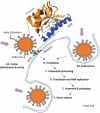Vaccines and vaccination: history and emerging issues
- PMID: 34582315
- PMCID: PMC8903967
- DOI: 10.1080/21645515.2021.1977057
Vaccines and vaccination: history and emerging issues
Abstract
Prophylactic vaccines are crucial in modern healthcare and have been used successfully to combat bacterial and viral infectious diseases. Infections like polio and smallpox, which were dreaded historically, and which devastated the human race over many centuries, are now rare. Smallpox has been eradicated completely and polio is nearly eradicated because of vaccines. Vaccines differ fundamentally from other classes of medicines in that they are usually administered as a preventive measure to a healthy individual rather than to a sick person already with an infection, although exceptions to this practice exist. Most currently used prophylactic vaccines are based on established platforms, but many vaccine candidates, in late development stages, including several COVID-19 vaccines, use highly novel vaccine platforms not available historically. History of infectious diseases and prophylactic vaccines are filled with important scientific lessons, and thus provide valuable insights for the future. With hindsight, historically there were some ethically questionable approaches to testing vaccines and the germ warfare against native populations in the Americas and other regions. In this review, we examine key historical lessons learned with prophylactic vaccines with reflections on current healthcare dilemmas and controversies with respect to influenza and COVID-19 vaccines.
Keywords: Vaccines; history of vaccines; infectious diseases; preventive medicines; prophylactic vaccines; vaccination; virology.
Figures


References
-
- Okwo-Bele J-M. Together we can close the immunization gap [accessed Aug 9]. https://apps.who.int/mediacentre/commentaries/vaccine-preventable-diseas....
-
- WHO Immunization. [accessed Aug 9]. https://www.who.int/news-room/facts-in-pictures/detail/immunization.
-
- The history of vaccines. [accessed May 3]. https://www.historyofvaccines.org/timeline/all.
Publication types
MeSH terms
Substances
LinkOut - more resources
Full Text Sources
Medical
